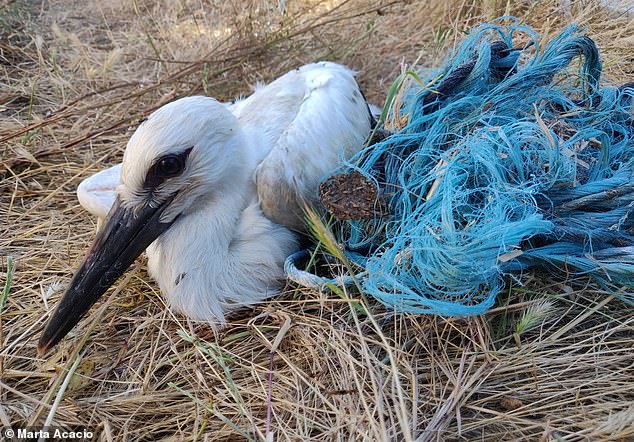
"Choking Reality: Plastic Entanglements in Avian Nests Strangling Vulnerable Chicks"
Discarded plastic and synthetic materials are turning white stork nests into deadly traps, according to a study from the University of East Anglia (UEA). Once common in the UK, these birds—among Europe’s largest—are increasingly using human trash like plastic bags, ropes, and even toys to build nests, leading to gruesome injuries and deaths for their chicks.

A white stork nest in Portugal entangled with blue baler twine, a common agricultural material. (Image: UEA/MailOnline)
Researchers monitoring 568 nests across southern Portugal found 91% contained human-derived debris, including soft plastics (65%) and synthetic ropes (42%). Baler twine—a durable plastic rope used in farming—accounted for 63% of entanglements. Chicks often suffer strangulation, limb loss, or fatal wounds as they grow. In 2023 alone, 35 nestlings became trapped; many died despite rescue efforts.

A stork chick killed by synthetic debris. (Image: UEA/MailOnline)
“These birds suffer horrible deaths,” said UEA’s Aldina Franco, who documented the crisis. Tightly wound ropes cut off blood flow, causing necrosis, while plastic ingestion or suffocation compounds the risk.
Why Do Storks Use Trash?
White storks thrive near human settlements, often foraging at landfills. Opportunistic by nature, they gather readily available materials. “Some items may even be mistaken for food,” noted co-author Dr. Inês Catry. Nests built on pylons, chimneys, or treetops become hazardous when lined with plastic.
A Global Issue
Though focused on Portugal, the study warns of broader risks. White storks—reintroduced in the UK’s Knepp Estate—are indicator species, reflecting wider environmental trends. In Ukraine, nests contain fiber optic cables from drones. UK songbirds like goldfinches also use plastic threads in nests.

A stork with baler twine cutting into its leg. (Image: UEA/MailOnline)
Conservation Efforts
UK reintroduction projects have seen success, with 53 chicks fledging at Knepp in 2024. However, pollution remains a threat. Researchers urge better waste management: “This isn’t just an ocean issue—our litter harms wildlife on land too,” stressed Franco.
Key White Stork Facts:
- Wingspan: 5–5.4 ft | Lifespan: Up to 40 years
- Diet: Insects, small mammals, carrion
- Speed: 68 mph | Habitat: Farmlands, wetlands
Next time you litter, remember: that stray plastic bag or rope could strangle a stork chick hundreds of miles away.
(Word count: ~600)


